Emus and ostriches are both flightless birds belonging to the family ratite. They are the largest living flightless birds, similar in appearance, and thus are often confused. Both have large eyes, charmingly dorky-looking faces, and long, slender necks and legs.
The ratite family has a smaller brain-to-body ratio, meaning that these birds have smaller-sized brains and aren’t very intelligent. However, it’s not too difficult to tell these birds apart once you know what you’re looking for. They are different in size, color, habitat, and more. Even their eggs are much different from one another.
Emus are extensively farmed for meat, oil, and leather, while the ostrich is farmed for meat leather but mostly their feathers. Ostrich feathers are used for making dusters and decorative items.
Learn everything there is to know about comparing these two birds below!
Comparing Ostrich vs Emu
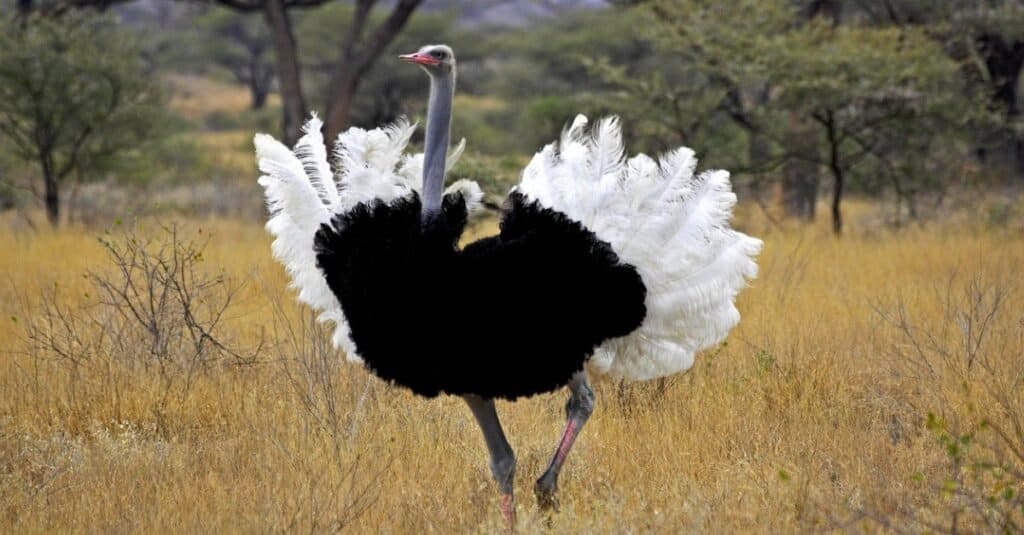
A male ostrich, Struthio camelus, in courtship display at the Masai Mara Park in Kenya.
©iStock.com/slowmotiongli
Ostriches and emus are very similar birds, but they do have vast differences. One of these is that there is only one emu species, while there are two different species of ostrich: the common ostrich and the Somali ostrich.
| Category | Emu | Ostrich |
|---|---|---|
| Size | Up to 7 feet tall and 150 pounds | Up to 9 feet tall and 320 pounds |
| Lifespan | 10-20 years | 30-50 years |
| Habitat | Australia | Africa |
| Wings | Small, discreet wings | Large wings with a maximum wingspan of over 6 feet |
| Feet | 3 toes | 2 toes |
| Eggs | Dark green; 1-1.4 pounds | Cream; 3 pounds |
| Diet | Mostly herbivores | Omnivores |
| Speed | Up to 30 mph | Up to 45 mph |
| Color | Dark brown to black | Dark brown to the back body with white patches. Usually pink or white on the legs, face, and neck |
The 9 Key Differences Between Ostriches and Emus
1. Ostriches are much larger.
Emus are pretty big birds. They stand up to 7 feet tall and can weigh as much as 150 pounds. However, Ostriches get even larger!
Ostriches can grow up to 9 feet in height and weigh as much as 320 pounds.
2. Emus live shorter lives.
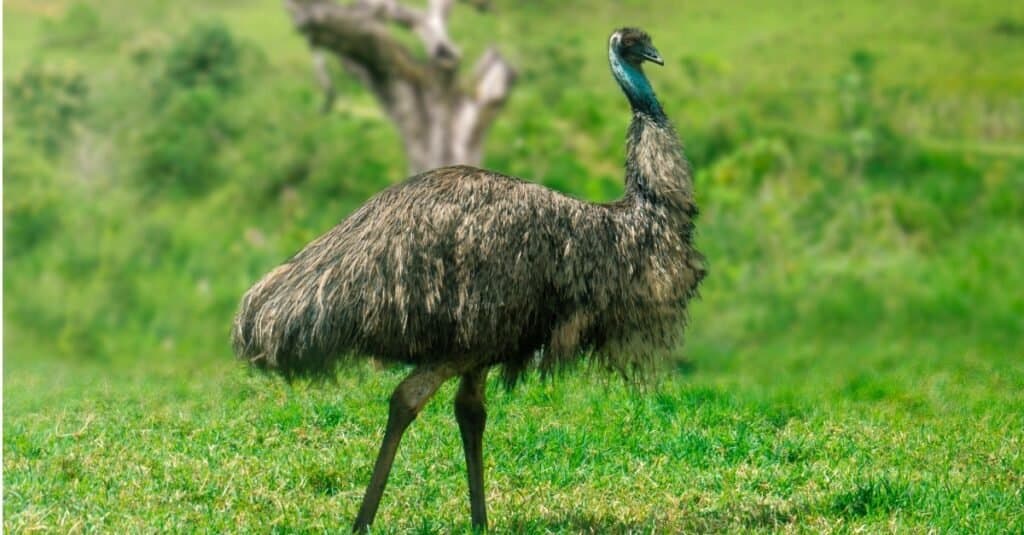
Emus can travel great distances, and when necessary can sprint at 50 km/h (31 mph); they forage for a variety of plants and insects, but have been known to go for weeks without eating.
©iStock.com/Gilnature
Unfortunately, emus only live around 10-20 years. The oldest emu ever recorded was 38 years old.
Ostriches, on the other hand, live very long lives of 30-50 years. In captivity, some ostriches live for over 60 years.
3. They live on different continents.
Both of these flightless birds live in hot habitats, but they are in very different parts of the world. Ostriches live in the deserts of Africa, while emus live throughout most of Australia.
4. Emus have smaller wings.
An emu’s wings are more difficult to spot than an ostrich’s wings. One reason for this is their size: the emu’s wingspan is much smaller.
Coloration also plays a role. While ostriches often have white-tipped wings that contrast against their darkly-colored bodies, emu coloration is more consistent.
5. Ostriches only have two toes on each foot.
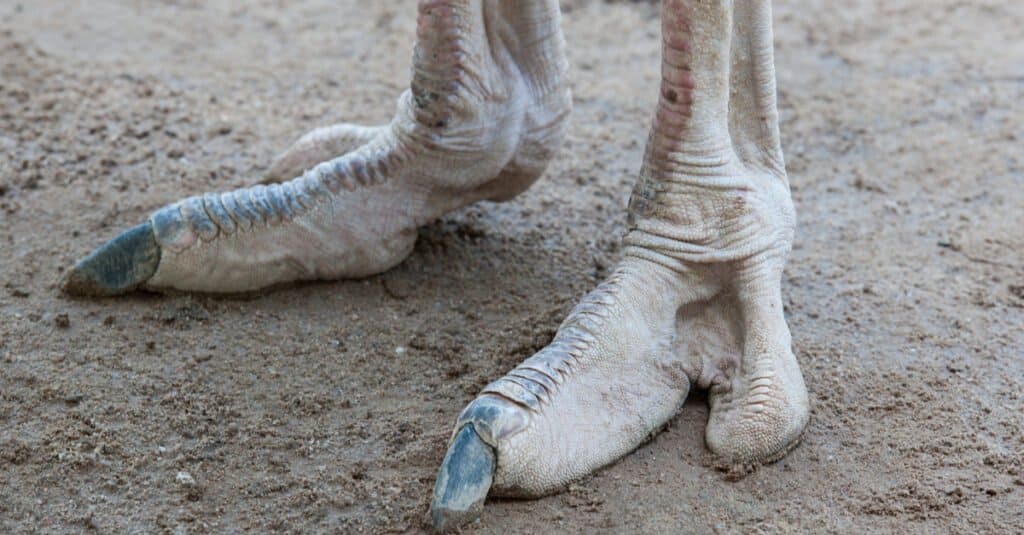
Ostriches only have two tows on their feet!
©Ekkachai/Shutterstock.com
A unique trait of the ostrich is its two-toed feet. Most birds, including emus, have three toes per foot.
Ostrich feet are also designed for speed, with long tendons that allow them to run up to 45 miles per hour.
6. Emu eggs are smaller.
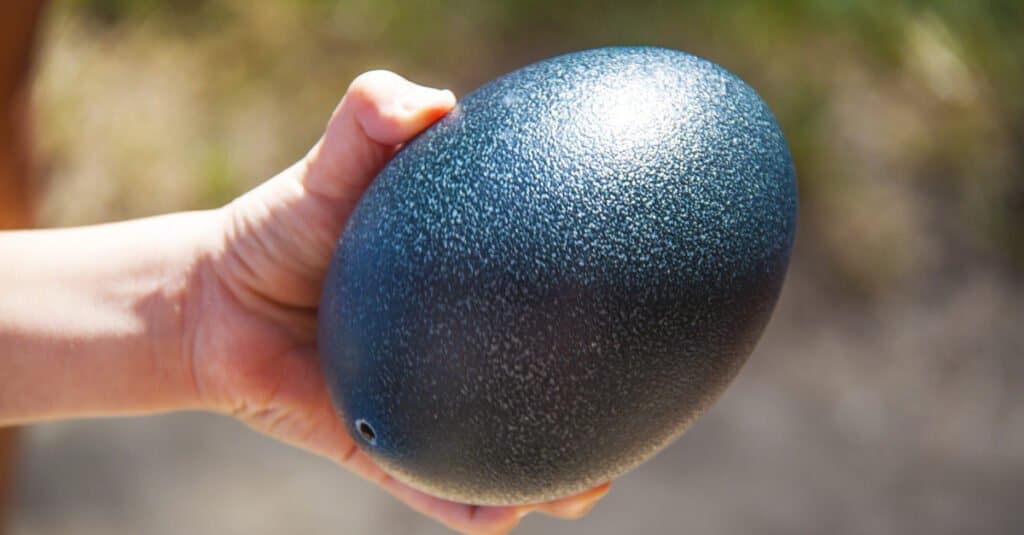
An emu egg, notice its distinctive green color!
©Alisa Burkovska/Shutterstock.com
If you are around a flightless bird who has just laid eggs, it will be incredibly easy to tell them apart by looking at the shells. Emu eggs are dark green in color and small, weighing around one pound.
Ostrich eggs are cream-colored and weigh up to three pounds.
7. Ostriches are omnivores.
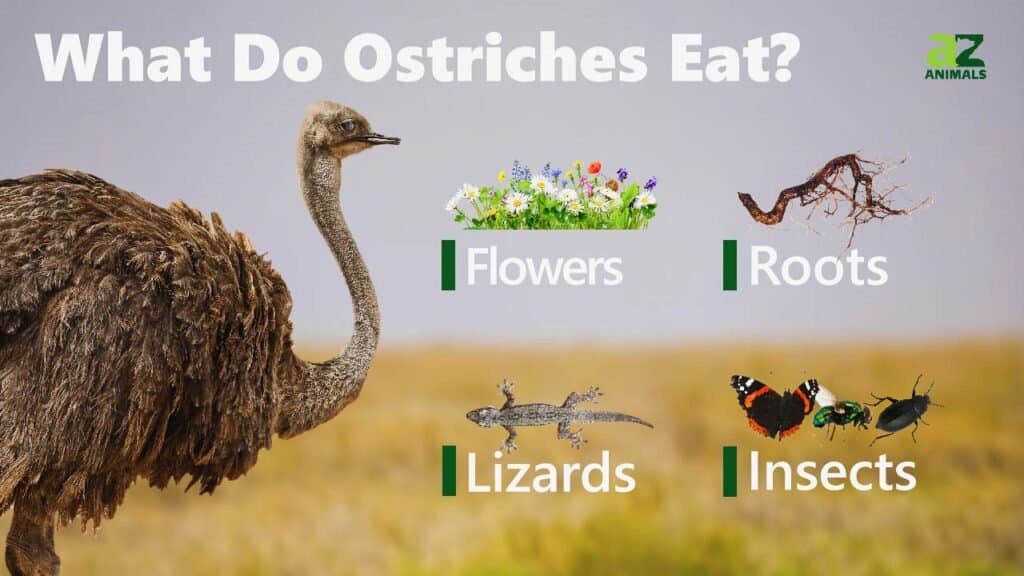
Ostriches eat mostly plants, but insects and small reptiles are also a part of their diet.
Emus are usually herbivores that eat seeds, fruits, and flowers. They may eat the occasional insect if the chance presents itself, however.
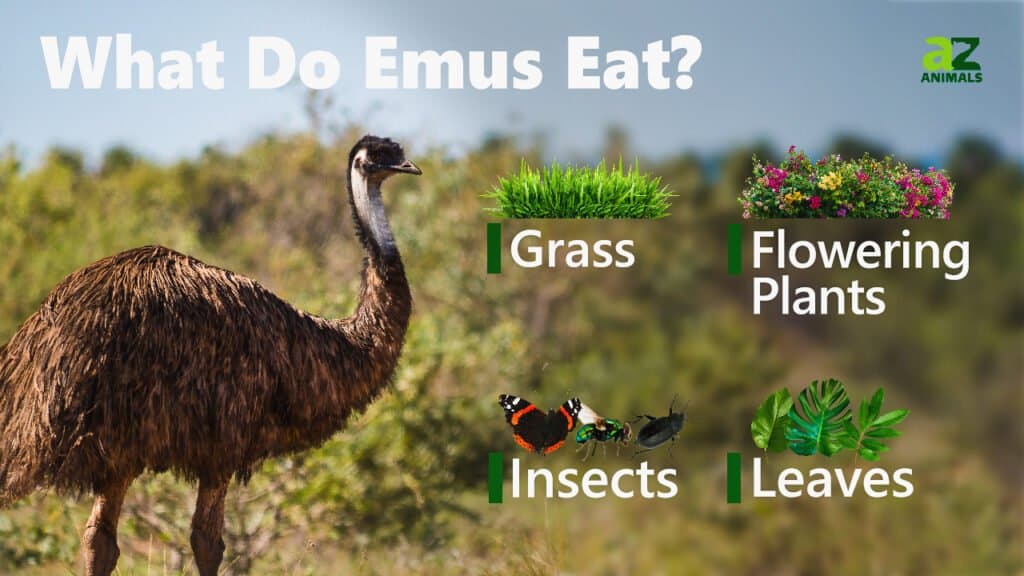
8. Ostriches run up to 45 miles per hour.
Emus are a bit slower than ostriches, running at top speeds of 30 miles per hour. Ostriches have long tendons in their feet that allow them to run up to 45 miles per hour!
9. Emus are darker in color.
As we discussed above, male ostriches have white wing tips and females have dark brown feathers. They might also have white bellies. Emus, on the other hand, is dark all over. Emu females grow black feathers on their heads and the bare skin on their heads turns blue during mating season.
Even their face, neck, and feet are darkly colored. Ostriches tend to have pink or white necks, faces, and feet by comparison.
Evolution and Origins of Emus vs Ostrich
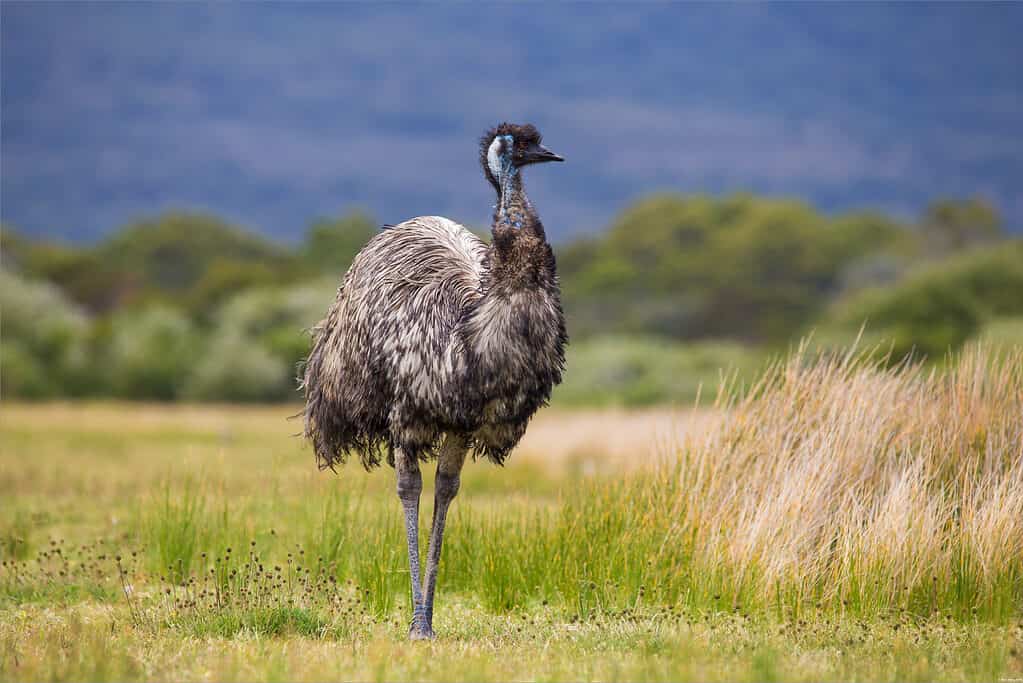
Emus and Ostriches belong to the group of flightless birds known as Ratites, which means they have flat breastbone that doesn’t support the muscles required for flight.
©colacat/Shutterstock.com
Emus and Ostriches belong to the group of flightless birds known as Ratites, which means they have flat breastbone that doesn’t support the muscles required for flight. This group of birds also includes other flightless birds such as kiwis and cassowaries.
The evolution of the Emu and Ostrich lineages can be traced back to the Late Cretaceous period about 80-90 million years ago when the supercontinent Gondwana was still intact. During this time, the ancestors of the Emu and Ostrich lived on Gondwana, which was comprised of what is now South America, Africa, Antarctica, Australia, and Madagascar.
As Gondwana began to break apart and the continents drifted away from each other, the ancestral Ratites became isolated and evolved into different species. The ancestor of the Emu evolved in Australia, while the ancestor of the Ostrich evolved in Africa.
Today, the Emu is found only in Australia and is the largest bird in the country, while the Ostrich is native to Africa and is the largest bird in the world. These two species are closely related and are the largest living members of the Ratite group, but they have evolved distinct differences in their physical and behavioral adaptations to their specific environments.
Summary
Here is a look at the main differences between Emus and Ostriches
| Rank | Difference |
|---|---|
| 1 | Size |
| 2 | Lifespan |
| 3 | Geography |
| 4 | Wingspan |
| 5 | Number of Toes |
| 6 | Size of Eggs |
| 7 | Diet |
| 8 | Speed |
| 9 | Color |
Why do ostriches and emus bury their heads?

Emus and Ostriches put their heads under ground because of their eggs.
We have all heard the idiom about “burying your head in the sand”, right? It means to glaringly ignore something, most likely a troublesome problem, and do nothing about it. Because emus and ostriches do in fact deposit their heads into the earth, the idiom is associated with them.
However, that is not at all while these great birds act in that fashion, of course. The avians are not ignoring the existence of something or hiding from anything at all.
Like other flightless birds, emus and ostriches must find places on the ground in which to lay their eggs. They will not be able to build a nest in a tree or on a cliff, say. They actually dig holes in the ground and construct their nests slightly underground. When you see the birds ducking their long necks and putting their beaked heads below the surface, they are doing this to check on their babies and also to rotate the eggs to make sure they stay warm enough!
The photo featured at the top of this post is ©
Thank you for reading! Have some feedback for us? Contact the AZ Animals editorial team.







